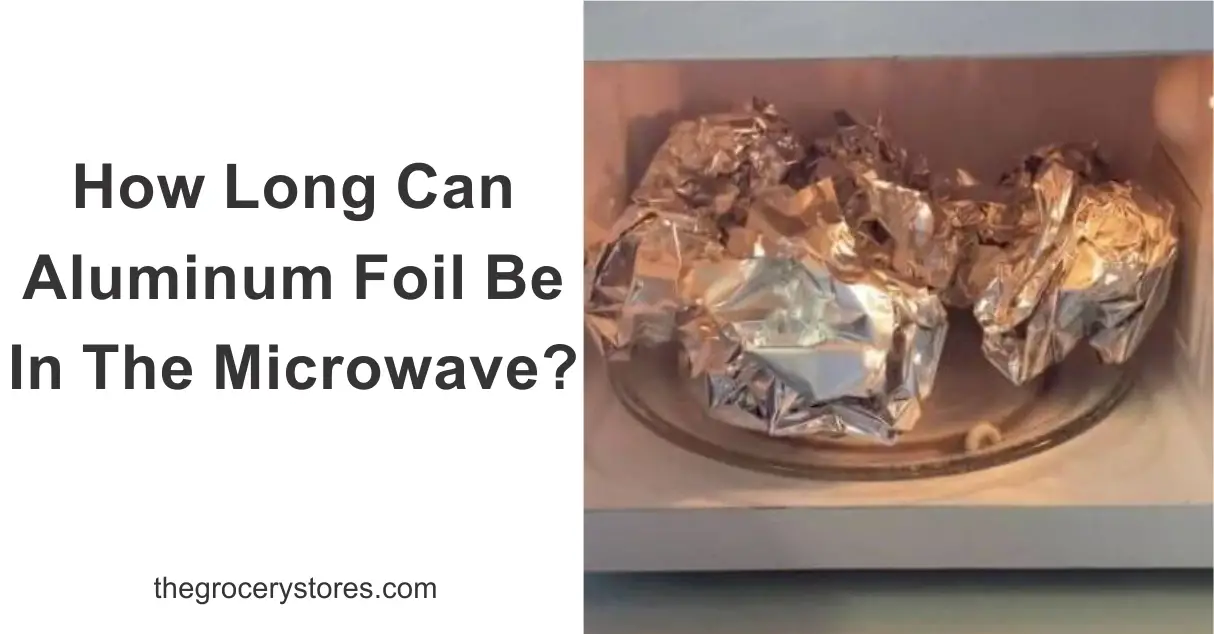Since 660 degrees Celsius (1,220 degrees Fahrenheit) is the temperature, you would need to raise the temperature to burn aluminum foil completely. This is considerably hotter than you might anticipate being able to achieve in a residential or commercial environment under a perfect scenario.
It would take a very high temperature to totally destroy aluminum foil. Until then, the foil can stay in your microwave for as long as you wish.
The microwave does not cause aluminum foil to burn. But that does not imply that aluminum foil can be used in the microwave without risk. Because it might spark and cause a fire or damage the microwave, aluminum foil shouldn’t be used in the microwave.
Is it safe to put aluminum foil in the microwave?
In most homes and restaurants, microwave ovens are one of the quickest ways to heat up food. Microwaves are radio waves with a frequency of about 2,500 megahertz. It is easy for moist food, water, and fats to absorb microwaves, whereas glasses, metals, and plastics cannot.
Since ovens are produced with metals to cover them , they act just like mirrors. A mirror reflects images, while an oven reflects microwaves. That is why using a
A very hard metal plate in the oven will not cook your food. However, using thin metals will allow electricity to flow through and warm your food.
Ovens use electrical currents to emit microwaves. These currents overwhelm thin metal objects, such as aluminum foil, and cause them to rapidly heat up. They can even start to spark because of how quickly they move. You would have to reach out for the fire extinguisher if there is any dry paper or inflammable object around.
What happens if you microwave foil for 3 minutes?
If you’re unfamiliar with microwaves, you might be curious about what occurs when you put foil in one. Does aluminum foil qualify as metal, since even the best microwaves dislike having metal inside the cavity? To learn more, keep reading.
Aluminum foil shouldn’t be left in a microwave oven for a long time, especially when the temperature is high. This is because the edges could spark and catch fire while the appliance is operating.
Since aluminum foil is relatively porous in comparison to other metals, it won’t protect your ingredients. In other words, they will still cook, but there is simply too much of a fire risk when using foil in your microwave. Instead, shield the food with a paper towel or a microwave-safe lid.
At what temperature does aluminum foil become toxic?
When used normally, a microwave can cook food products or liquids to a maximum temperature of 200 degrees, but solid foods typically do not reach that temperature due to evaporation.
It’s advised not to cook anything on or in aluminum foil at temperatures exceeding 400 degrees Fahrenheit, and not to wrap acidic foods in aluminum foil for extended periods of time.
Can you heat up food in a foil container?
Most medicine, water, and food we consume contain some amounts of aluminum. However, it is usually passed out through fences or urine. Many people are very conscious about what they eat and try to make sure that they reduce the risk of having any disease that is associated with aluminum toxicity.
It’s safe to use foil containers in the oven. Because it conducts heat well, the food is perfectly heated and the heat is distributed throughout. However, you must watch out that the container doesn’t touch the sides of the oven because doing so could result in dangerous sparks.
Even though there is no big issue with consuming normal and small amounts of aluminum, we do not know if they exist in our food. We can also do well to avoid it from decomposing in our food by minimizing the rate at which we use aluminum foil to heat up or wrap foods, especially at high temperatures for a long time.
Can foil catch on fire?
The use of aluminum foil in kitchens is extremely common. In fact, aluminum foil has been a very convenient and affordable way to package food for most restaurants since around 1920.
Only at extremely high temperatures can aluminum foil catch fire because it is not flammable. However, it is possible for aluminum foil to become discolored when heated in a fire, which could mislead someone into thinking it has caught fire when it has not. Impurities from the fire’s smoke that were attracted to the aluminum foil’s surface are what caused this discoloration.
Aluminum foil won’t burn until it reaches about 1220 degrees Fahrenheit (660 degrees Celsius). Aluminum foil, which is occasionally referred to as “tin foil,” is pure aluminum that has been shaped into extremely thin metal leaves.
What happens if you accidentally microwave a fork or a spoon?
Never microwave anything made of metal! You have likely heard that before, but you might not be aware of the context. Electromagnetic waves and metal don’t get along, obviously.
Sparks fly everywhere when metal is heated in a microwave. A spectacular light display results from the electromagnetic waves being converted back into electricity.
The most likely cause of your microwave sparking while it operates is that there is metal inside. Perhaps you forgot to take the spoon out of the coffee or put some aluminum foil on the leftovers. Sparking can result from even a small piece of steel wool that was left over after cleaning.
Is it safe to eat food that is sparked in the microwave?
When microwaves strike a metal component inside the oven, it usually results in sparks. Metals conduct electricity well because they have many free-moving electrons.
Foods with fat and sugar are easily absorbed by microwaves. When metal is placed inside the appliance, the microwaves move the electrons, resulting in heat and sparks. If you are microwaving your food and the oven sparks, you can only eat the food if it was covered and there was no visible damage done to the food. Otherwise, dispose of the food, repair the microwave oven, and also study to know what caused the spark.
You should know by now that many foods we put in the microwave can cause damage and sparking.
What shouldn’t you microwave?
Using only microwave-safe materials is the simplest way to prevent your microwave from sparking. Avoiding certain substances is best because they are certain to ignite sparks.
Below is the list of things you should never put in a microwave:
- Metal cutlery: Sparks and arcing electricity are a given when using thin metal tines. Using a spoon isn’t much better. Avoid using your microwave for cutlery.
- Tin foil: Tin foil is an excellent way to unintentionally ignite a microwave. The electromagnetic waves are almost perfectly reflected by the metal. Food should be unwrapped before being microwaved.
- Steel: The same reason that forks and tin foil cause sparks also applies to steel wool. You’ll have more issues because steel wool may be flammable, which is even worse. Use something else to clean your microwave.
- Grapes, raspberries, and strawberries should also not be put into a microwave. This is because they produce a unique hot spot reaction that will make their plasma get weak and burst. The water enters the interior of the oven, causing sparks. However, if you no longer need your microwave, it’s a fun experiment.
Can I use my microwave after it sparks?
Nothing is more terrifying than trying to warm meals in the microwave only to see sparks. There are many issues that can start to spark in your microwave.
A sparking microwave can be hazardous.
You are at high risk of electrocution if the microwave is sparking as a result of malfunctioning electronics. Simply unplug the microwave if you’re unsure of whether it’s secure. By doing so, you’ll be able to stay safe and thoroughly investigate the issue.
The interior of your microwave will suffer permanent damage from sparks. Sparking microwaves, while not harmful to you, pose a risk of becoming damaged almost beyond repair. Especially when you do not treat it immediately upon noticing it.
Can a microwave explode with nothing in it?
A magnetron is an electronic tube that produces microwaves in an oven. Food absorbs these microwaves, which are designed to be reflected from the interior of the oven. These emitted microwaves make the water molecules in anything put inside the oven vibrate and produce heat high enough to cook the food or substance in it.
When you start an oven without food inside or any substance to absorb the microwave emitted, the waves and heat bounce back to the electronic tube. Because of the dry and confined oven, a fire could start and damage the equipment.
Instead of heating your breakfast, you are cooking your magnetron. Depending on how long you allow the oven to be on, it will spark up. You will need to replace the units before it will work again. But it is only on very rare occasions, like high voltage or reactive chemicals, that the microwave will explode.

